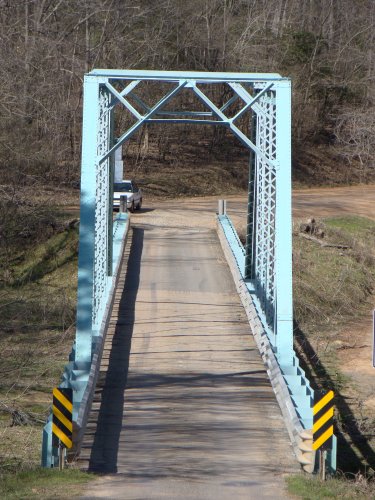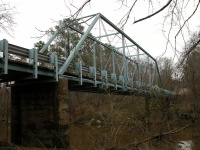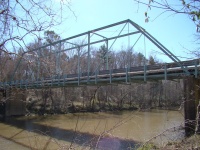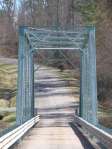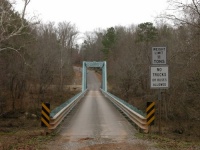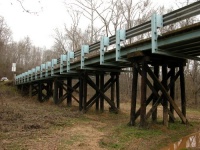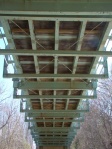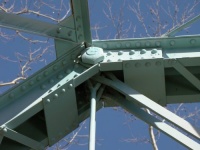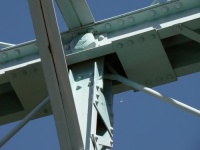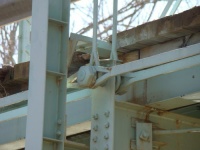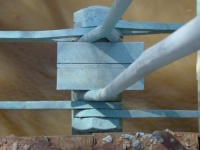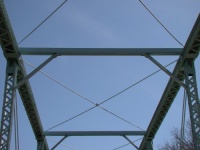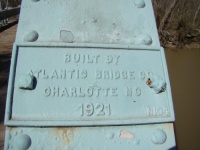Rocky River Truss Bridge
Rocky River Truss Bridge
Chatham County Bridge No. 147 on Chatham Church Road
There are two truss bridges standing today in Chatham County, North Carolina, the other being the Deep River Camelback Truss bridge. Of the two this is the one that gets the least attention: it is the youngest, having been built in 1921; it has the shortest main span; and hasn't been placed on the National Register of Historic Places. However, it does have one notable distinction: it still carries traffic. Even as the county becomes less rural (and charming) due to spread of suburbanization from Orange and Wake Counties, this one-lane truss has been left in place. Why? you may ask. Why hasn't it been condemned to the furnace, like so many other truss bridges that were once owned by the NCDOT? A likely answer can be found by looking at the bridge itself.
The main span of the bridge is a Pratt truss, one of the most common truss bridge designs (though a novelty in NC nowadays). Despite its 1921 construction date it is more akin to a late 1800s bridge, notably because of its pinned connections. By this time period the riveted gusset plate connection was predominant, likely because it was stronger (see my page on Wilmington, NC's 6th Street Bridge, for example). Another feature that makes this bridge more like one from the 1800s is the relatively "frail" structural members, including diagonal ones that are steel rods. The bottom chord is comprised of a series of eyebars, as opposed to being a solid one. This is not to say that these features were uncommon on bridges during this time period. In all likelihood, however, one carrying a large amount of thru traffic would have been built with heavier components. This is not to say that the bridge is unsafe. It has an 8-ton weight limit, which is more than sufficient to carry a car or two at a time on the main span. At the same time, even when it was new it probably wasn't meant to carry one tractor trailer after another.
Thus, while I won't say that this bridge never carried thru traffic for the Pittsboro-Sanford road that became US 15-501, it does seem that it was never built for this purpose. The present day alignment of 15-501 is located downstream and out of sight of this crossing, and appears on maps as early as 1933 (and may have existed before that). It then appears that it has carried small amounts of rural traffic for most of its existence, as it does today. This could change if it was decided to put in a school or subdivision on the road. But for now the bridge's future appears to be secure, as virtually all traffic across the river is carried by the modern bridge. Few want to drive down the rough gravel road leading up to its northern approach.
There are twelve steel stringer approach spans leading up to the bridge, which are supported by pine columns. Whether these are original or were replaced in the 1959 rehabilitation of the bridge I can't say. However, a few of them have been reinforced.
From a layman's point of view the bridge appears to be in very good condition. The light blue paint (which is also has aesthetic appeal) appears to be adhering to the steel very well, as there is little rust on it. However, it is rated as "structurally deficient." The foundation, notably, is rated as "serious," possibly due to the uncertainty of whether the piers will be able to withstand the scouring caused by floods. The deck could certainly use some attention. It is an asphalt surface paved over the wooden deck. The main problem with this strategy is that the wood compresses over time, causing the asphalt to crack and sink, becoming nearly as bumpy as what is underneath. Personally I would rather see a historic bridge have the same kind of deck it was built with. But I can see how an asphalt deck would make sense for maintenance purposes.
Facts
- Year built: 1921
- Year Reconstructed: 1959
- Builder: Atlantic Bridge Co. of Charlotte, NC
- Route Carried: SR-1953
- Crosses: Rocky River
- Location: Chatham County, NC
- Design: 6 panel Pratt truss with pinned connections and steel stringer approaches
- Length of main span: 120.1 ft. Total length: 360.9 ft.
- Inside width: 11.2 ft., one lane
- Sufficiency Rating: 19.4 out of 100
- National Bridge Inventory ID: 370147
- Coordinates: 35°37'25.15"N 79°11'57.03"W
Pictures
- Left: Oblique view, upstream. Center: Downstream view. Right: Portal view
- L-R: The bridge and its northern approach; part of the northern approach; the underside of the main span (notice the pine planks).
- L-R: A front post/upper chord connection, an upper chord/vertical member connection, and a lower chord connection.
- L-R: A lower chord connection, closeup; bracing and the upper chords; the simple builder's plaque.
